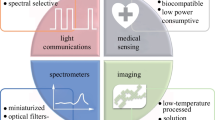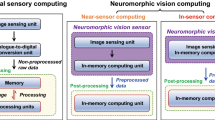Abstract
In this paper we present an embedded network camera processor (NCP) system on a chip (SoC) for various low-power multimedia applications. The NCP SoC comprises a digital camera processor optimized for a CCD sensor, a motion JPEG encoder to compress the data, an Ethernet controller to transmit the data, ARM processor and many peripherals. Using the NCP SoC allows the raw image from a CCD sensor to be filtered, compressed and transmitted anywhere through various Ethernet protocols, with no additional hardware. The NCP SoC is designed with Verilog-HDL. Also, we followed a strict ASIC flow including functional behavior verification and a scan test. The NCP SoC is fabricated with 0.25 \({\upmu }{\text {m}}\) CMOS technology. The total chip size, including embedded memory, is \(7800\times 7800\,{\upmu }{\text {m}}^{2}\) and the gate count is 1.2 million. The NCP SoC runs at up to 48 MHz, and supports various slower clock frequencies for low-power applications requiring additional power saving modes: 6 MHs, 12 and 24 MHz at 2.5 V.


























Similar content being viewed by others
References
Weiser, Mark. (1993). Some Computer Science Problems in Ubiquitous Computing. Communications of ACM, 36(7), 75–84.
Morikawa, Hiroyuki, & Aoyama, Tomonori. (2004). Realizing the Ubiquitous Network: the Internet and Beyond. Telecommunication Systems, 25(3–4), 449–468.
Joo, S. C., Jeong, C. W., & Kim, K. H. (2011). A Study of Context-Based Adaptive Service Model in Home Environments. Telecommunication Systems,. doi:10.1007/s11235-011-9550-0.
Hannikainen, M., Lavikko, T., Kukkala, P., & Hamalainen, T. D. (2003). TUTWLAN - QoS Supporting Wireless Network. Telecommunication Systems, 23(3–4), 297–333.
Zen, H., Koizumi, T., Yamamoto, H., & Kimura, I. (1998). A New Digital Signal Processor for Progressive Scan CCD. IEEE Transactions on Consumer Electronics, 44(2), 289–296.
Nakano, N., Nishimura, R., Sai, H., Nishizawa, A., & Komatsu, H. (1998). Digital Still Camera System for Megapixel CCD. IEEE Transactions on Consumer Electronics, 44(3), 581–586.
Kim, H., Kim, J., Hwang, S., Park, I., & Kyung, C. (1998). Digital Signal Processor with Efficient RGB Interpolation and Histogram Accumulation. IEEE Transactions on Consumer Electronics, 44(4), 1389–1395.
Okada, S., Matsuda, Y., Yamada, T., & Kobayashi, A. (1999). System on a Chip for Digital Still Camera. IEEE Transactions on Consumer Electronics, 45(3), 584–590.
Kami, H., Kurashige, T., Higashi, M., Imaide, T., & Kinugasa, T. (1999). A Network MPEG Camera. IEEE Transactions on Consumer Electronics, 45(4), 1206–1212.
Park, J., Oh, S., & Lee, Y. (2013). Network security camera system and its application for consumer electronics in ubiquitous environment. Multimedia Tools and Applications,. doi:10.1007/s11042-013-1442-8.
Shobatake, Y., Motoyama, M., Shobatake, E., Kamitake, T., Shimizu, S., Noda, M., et al. (1991). A One-Chip Scalable 8*8 ATM Switch LSI Employing Shared Buffer Architecture. IEEE Journal on Selected Areas in Communications, 9(8), 1248–1253.
Weldy, J. A., & Kristy, S. H. (1987). Single Sensor Color Video Camera with Blurring Filter. U.S. Patent 4,663,661.
Greivenkamp, J. E. (1986). Optical Spatial Frequency Filter. U.S.Patent 4,575,193.
Zen, H., Kim, S., Jang, J., Chun, H., & Lee, C. (1994). A New Digital Camera Processor with Separated Y and C Gamma Control. IEEE Transactions on Consumer Electronics, 40(3), 610–615.
Weldy, J. A. (1989). Optimized Design for a Single Sensor Color Electronic Camera System. Proceedings of SPIE, 1071, 300–307.
Johansson, H., & Lowenborg, P. (2002). Reconstruction of Nonuniformly Sampled Bandlimited Signals by means of Digital Fractional Delay Filters. IEEE Transactions on Signal Processing, 50, 2757–2767.
CCIR Recommendation 656–2. Interfaces for Digital Component Video Signals in 525-line and 625-line Television Systems.
CCITT Recommendation T.81. Digital Compression and Coding of Continuous-Tone Still Images (JPEG).
IEEE Std 802. 3. Carrier Sense Multiple Access with Collision Detection (CSMA/CD) Access Method and Physical Layer Specifications.
Sakamura, K., & Takada, H. (1999). \(\upmu \)-ITRON version 4.0 Specification. TRON Association. http://ertl.jp/ITRON/SPEC/FILE/mitron-400e.pdf. Accessed 14 Dec. 2011.
Ahn, H., Cho, M., Jung, M., Kim, Y., Kim, J., & Lee, C. (2007). UbiFOS: A Small Real-Time Operating System for Embedded Systems. ETRI Journal, 29(3), 259–269.
Acknowledgments
This research was supported by Basic Science Research Program through the National Research Foundation of Korea (NRF) funded by the Ministry of Education (2014R1A1A2A16053925).
Author information
Authors and Affiliations
Corresponding author
Rights and permissions
About this article
Cite this article
Park, J., Moon, S., Oh, SH. et al. Embedded network camera processor system on a chip for various low-power multimedia applications. Telecommun Syst 60, 251–260 (2015). https://doi.org/10.1007/s11235-015-0027-4
Published:
Issue Date:
DOI: https://doi.org/10.1007/s11235-015-0027-4




